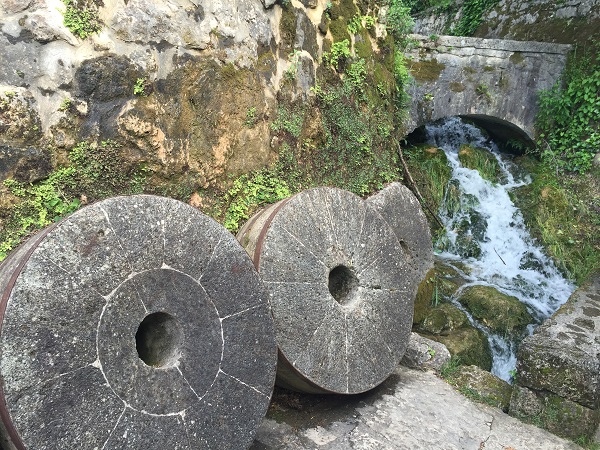
For Part I of Destination Croatia - Discovery and Exploration, see http://www.chronicle.lu/categoriestravelopinion/item/16902-geoff-thompson-destination-croatia-discovery-and-exploration-part-i
Biograd
We stayed the second night at another of LuxairTours' partner hotels, the Hotel Ilirija in Biograd, further up the coast. The 4-star water-front hotel offers a wellness centre providing an array of services, and its Restaurant Marina Kornati offers a buffet meal, with plenty of choice, in the evenings. A marina is in full view from the hotel rooms and the hotel bar offers a commanding eye-level experience of the nautical comings and goings.
The small marina in front of the hotel houses the smaller pleasure craft, while the larger one is situated just around the corner and is the base from which the teams competing in this week's Siggy's Cup (Luxembourg's corporate sailing competition) are operating - the day we were there the participating craft were south, between Dugi Otok and Murter, and due to return to Biograd that evening.
Wine-Tasting & Cuisine
Inland, the ground is surprisingly fertile, at least compared to what we have seen along the coast for the past couple of days, with much of it used as arable land for growing crops, and later on for vineyards and orchards of fig trees and olive groves, with many producers adopting organic practices.
15 minutes outside Biograd, we stopped off at Iliriga Biograd for another sampling session of local brews, including sherry, wines and liquers, before moving on for something to eat. The property has been in the same family for 600+ years and includes their own distillery. The property has been developed as an agri-tourism centre, with renovated chalets, a swimming pool and more for residential guests, as well as the facilities for hosting events from seminars to weddings, catering for up to 60-75 people at a time. Of the wine produced here, 70% is red and 30% white; they have their own winery which produces around 4,000 litres annually. Traditionally the wines from this region are blends of grapes from local varieties (that can thrive in the soil unlike traditional varieties which have deep root systems) producing both quality and quantity.
Another short trip in the minibus and we stopped a second winery, Skaulj, for a quick tour before lunch. It's a family business producing 5 different varieties of organic red wines, much of the 80,000+ litre production being for the export market, using traditional grape varieties, as well as local varieties. The Skaulj winery offers Merlot, Cabernet Sauvignon and Maraština, as well as Syrah, Cuvee and Tomislav; some of their wines have won medals at prestigious international festivals.
One of the challenges of both these wineries is that, although the people in both are extremely friendly, welcoming and accommodating, the locations are rural and would be difficult to locate unless going on an organised tour with a driver who knows how to access both places.
To eat, we were served up charcuterie starters of cold and smoked meat and triangular pieces of local cheese, with main courses of trays of barbecued meat (mainly pork chops, lamb chops, veal steaks and some chicken) and of grilled fish (from whole squid and octopus tentacles to white fish, etc.). In addition, for two meals we were served pasticada, a meat stew cooked in the traditional way of covered skillets on embers. Traditional side-salads were also served with most meals in place of vegetables. While Croatia has specific regional differences in its cuisine, coastal cooking involves the use of herbs and some spices, with both fish and meat part of the staple diet and traditional dishes.
Zadar
The origins of the city of Zadar date back 3,000 years; it it strategically positioned on the end of a peninsula and parts have been restored, including architectural remains dating from the Roman and Venetian periods. Part of the city has a significant Italian influence as a result, with flagstones at the former Roman Forum dating back over two millennia.
Taking advantage of a guided walking tour of the city, starting from the People's Square and also taking in the 5 Sisters Square, we learnt the 5th largest city in Croatia has no less than 44 churches on the peninsula alone. The city is spotlessly clean, like all the towns and villages we visited, and easy to explore thanks to the stone pavements in the pedestrian city centre; all we needed was a map illustrating the main attractions, both historical and cultural. These extend to the waterfront walkways and piers, with the unique sea organ creating music from the motion of the sea, not unlike the sounds of whales, a hypnotic sound from another wonder of nature. Then there was the celestial circle which is fed by photovoltaic cells during the day and which emits a rhythmic light display once the sun goes down.
The city also has a number of marinas, in keeping with the nautical influence of the rest of the country's coastline onto the Adriatic Sea.
Overnight was at the hotel Falkensteiner, located 10 minutes by road outside the city; with spacious rooms and modern 4-poster double beds, all flooring and furniture in light wood; the breakfast buffet in the morning was extensive, offering everything from cereals and fruit, cold meats and cheese, breads and pastries, to a range of cooked alternatives, both meat and vegetables.
Plitvice
On the 3-hour drive to the country's capital, Zagreb, we stopped off at another of Croatia's national parks, at Plitvice. The drive brought us up through forests and hillsides, where the villages would not have been out of place in the Black Forest or the Tyrol, such is the architectural style of the houses and buildings. For parts of it, specifically driving through the (primarily) deciduous forests, we could even have been back home in Luxembourg.
Upon stopping briefly at one of the local hostelries en route, it was apparent that this terrain is home to a number of large wild animals, from brown bears and deer, to wild boar, badgers and more. Roadsigns indicated that numerous facilities existed for adventure sports in the area, including rafting and quad biking, as well as kayaking and fishing (for trout and grayling).
Plitvice is the oldest of Croatia's eight national parks and is a Unesco heritage site. It has a series of walking trails, boat rides and a tourist train, with the various series of waterfalls the main attraction, as well as hundreds of species of birds, bats, orchids and butterflies that live there.
The waterfalls are indeed truly spectacular, both higher and more numerous that at Krka. When we were there, however, the weather was somewhat overcast, thus preventing the sun from showing off the glorious aquamarine colours of the water, as we had experienced in Krka. But what helped immeasurably was the extensive network of boardwalks - in great condition - which enable visitors to maintain a sure footing. While we were making our way through the forests, moving from one level to another, passing waterfalls and lakes both large and small, there were two persistent sounds - that of the falling water and that of the myriad of birds, enduring an incredible audio experience, as well as being visually stunning.
Arguably keeping the best until last, The next stop was at Rakovica in Slunj, also known colloquially as "Little Plitvice". The village used to be a milling centre, with just four mills remaining, with groups able to visit. While most people will bypass the town and not witness the exceptional waterfalls, those who do stop are in for a real treat; water flows snd cascades beside, under and around houses, all merging into the confluence that then slows down as it meanders downstream. Apart from the main flow, many of the other tributaries are very short as much of the water originates from underground springs. Due to the limestone bedrock, the area has many caves, some favoured by speleologists, with one cave accessible from behind one of the waterfalls in the centre of Rakovica.
To sum it up in one sentence, Croatia is a country with an incredible coastline and outstanding natural beauty where one would go to Discover and Explore the Dalmatian coast, sail in the Adriatic Sea and visit islands, or visit the national parks inland - or a combination of any or all the above.
How to get there: Luxair / LuxairTours fly weekly Luxembourg-Zadar-Dubrovnik-Luxembourg: see www.luxairtours.lu or www.luxair.lu. This enables visitors to avail of a choice to base themselves at either destination, or start at one and work their way along the coastline to the other, exploring and discovering along the way. The only restriction here is that the LuxairTours / Luxair flights are on Mondays only - at least, at present - so for those who prefer to return another day can take in Plitvice on the way to Zagreb airport, as we did.
For Part I of Destination Croatia - Discovery and Exploration, see http://www.chronicle.lu/categoriestravelopinion/item/16902-geoff-thompson-destination-croatia-discovery-and-exploration-part-i
Photos by Geoff Thompson (for full photo album (on Facebook) see https://www.facebook.com/media/set/?set=a.873158812795425.1073741908.238112732966706&type=3)









